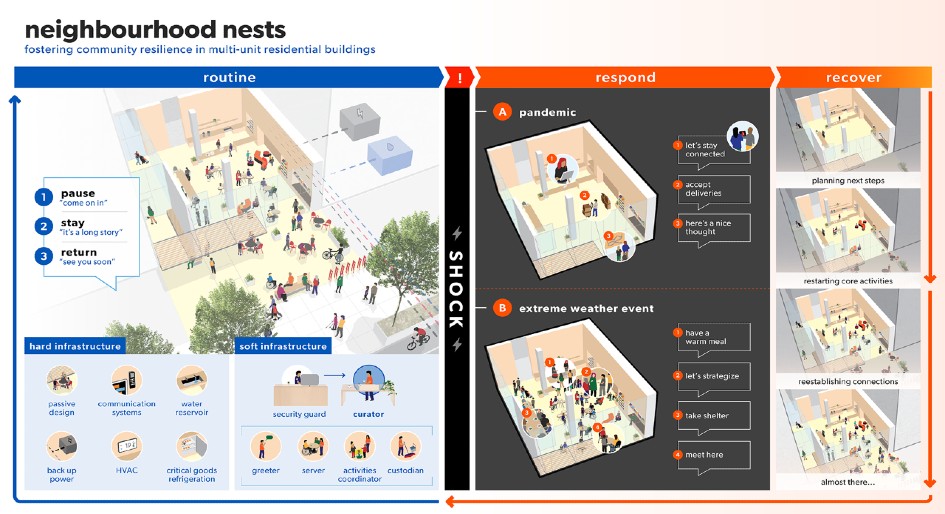Several condo communities across southwestern Ontario with larger concentrations of senior citizens quickly watched their everyday routines change like quicksilver as the pandemic hit. Paper copies of board meeting packages and hand-delivered notices morphed into virtual meetings, electronic messaging and crash courses in Zoom.
“Suddenly, people had to figure out how to communicate and do that safely for everyone,” says Casey Beacock, president of Sanderson Management Inc. and president and director of the Grand River Chapter of the Canadian Condominium Institute. “What made our boards survive was their ability to adapt to change and not be afraid of it.”
Managers and boards have long been tasked with preparing communities for uncontrollable events. The pandemic is revealing some gaps while testing the resilience of condo communities—enhancing communication channels, rethinking technology and even reimagining the way common spaces are designed and used.
Connect and Communicate
For Debbie Dale, president of MCRS Property Management, positive relationships among residents are evolving as they face protocols together.
“Communicating in a time of crisis is a quintessential element to successful survival as a community collective,” she says. “Ideally, the communities that have successfully communicated in these difficult times are the ones that will truly excel in the future through the lessons learned—together.”
For Judy Statham, president of ICC Property Management, clear and constant communication is something to strive for always and especially now.
“At the onset, due to mixed demographics with varying degrees of understanding, acceptance, needs for amenity spaces and usage of their condo dwellings, there were diverse viewpoints on the severity of the pandemic, as well as acceptance of protocols put in place by the board, with management recommendations,” she says. “We have seen our communities pull together and help one another during this time. Continuing to manage our communities with care and proper communication and listening to our residents has and will continue to ensure our condominium corporations are strong and resilient.”
Part of Beacock’s job, to an even larger degree now, includes listening. For property managers, she says, this pandemic is about learning how to listen actively.
“People are home, so there is a lot more communication coming in,” she says. “They were typically too busy before so we didn’t hear from them until we needed to; now we are hearing from people every day— sometimes those we have never heard of, who have lived in the condos for years.”
Catching COVID-19 could mean serious infection or hospitalization for those who are more vulnerable in her buildings. This requires a tailored perspective by which to manage.
“You have to think about the plan moving forward and be prepared to go slow—we tend to lag behind what is allowed provincially a bit just because our demographic is vulnerable for the most part,” she adds. “But they don’t always understand that either—they’re tired of being locked down and isolated.”
To help a community’s most vulnerable residents absorb the shock of such a crisis, “support, care, empathy and understanding the various economic, social and physical limitations of the communities should all be considered,” Statham points out.
Uneducated assumptions should also be avoided, says Dale. Resilience cannot be successfully created without living and learning another’s experience. She suggests that a confidential survey to pull out variables and define commonalities is a great first step, along with direct engagement.
“Vulnerable populations require specifically crafted measures to protect their rights and entitlements in a respectful manner,” she says. “There is no one-size-fits-all approach to simply copy and paste repeatedly. Understanding the goals and needs of each individual or defined group yields the basis from which to draft potential resiliency driven measures.”
Hi-Tech, Low-Tech
Technology also plays a role in building stronger, more cohesive communities, helping to facilitate connections among residents, owners and staff.
“Technology has proven to be an invaluable tool, prior to the pandemic, and even more so now,” says Statham. “It allows us to communicate frequently and accurately without the need to print and post notices, track maintenance items, conduct inspections and host board and owner meetings.”
A few critical tools ICC has deployed at their Greater Toronto Area properties include email, a community website or portal, a video chat conference line, cloud-based servers to access corporation records, VPN connections for remote access and IP cameras to view footage.
The need to virtually monitor both operations and compliance and enhance the community has also pushed many condos to embrace mobile technology, says Jason Reid, senior adviser for Fire & Emergency Management with National Life Safety Group in Toronto. This includes the ability to track cleaning requirements, security guard patrols, virtual board meetings, property inspections and even amenity bookings,
“Technology is not only leading operations; it’s enhancing community safety,” he says. “Today, condos in Toronto can even allow the fire department to send text messages to residents during evacuations and power outages.”
While technology may never replace an experienced “boots-on-the-ground superintendent or concierge at the front door,” it’s been proving its worth lately—such as the Ontario government’s emergency order allowing condos to conduct virtual meetings and e-voting, whether or not they have a bylaw permitting so.
“Even the screen-sharing aspect in a virtual meeting is a great resource,” says Dale. “We can keep the entire board focused on one subject matter as a group fairly easily, which is hard to do in a live meeting. For a virtual owners’ meeting, I suspect the more timid folks will be empowered, too, to participate as they tend to stay quiet in large groups.”
The emergency order on allowing virtual meetings, however, is fleeting. Whether or not most condos will pass a bylaw before the order ceases is unclear. Some managers believe that to implement one would at least offer a choice for boards going forward.
“This sets the corporation up for success over the years in making it easier for directors, who travel or go south for months at a time, to still participate effectively, thereby hanging on to that valid volunteer resource pool,” says Dale.
Besides new methods that help the business side of a condo corporation, Director of the Condominium/Strata Group at McIntosh Perry Consulting Engineers Jon Juffs, foresees the social networks of a corporation developing more over the next few months, such as more variant social media communication that promotes interconnectivity and conversations.
Condos will not only be able to reach out among their own communities, but also connect with similar condos elsewhere—perhaps to acquire free expert advice or opinions, he says. For instance, a 60-unit townhouse corporation in suburbia might want to talk to another 60-unit condo in another suburb to see what challenges they face with completing pavement markings. Potential advancements could also support more vulnerable residents, he notes, such as an electronic Neighbourhood Watch-type program that monitors the lack of activity in a condo’s light fixtures.
“People would be able to react more quickly, but it will be a tougher challenge,” he says. “I don’t think it will get that invasive, but rather boil down to the practical realities of keeping our communities safe and better informed, and potentially having far-reaching consequences, like saving money, as residents understand their time of use.”
Canadians believe emerging technologies are helping to improve communities by making them safer, more efficient and environmentally sustainable, according to research last year from the Consumer Technology Association. However, the Emerging Technology in Canada: 2019 Consumer Sentiment report found there are regional gaps when it comes to awareness of tech innovations, from smart home devices to 5G connectivity, with a greater recognition found among Torontonians. Such sentiment translates to condominium communities.
“Condo communities have such diverse demographics, so in the urban centres there is a tendency to have a great deal of acceptance of technology as a means of conducting business or staying socially connected,” says Juffs. “That is less so when you get into the more suburban, rural areas where the demographic tends to be a little older.”
He remembers back to when people insisted mail be delivered by Canada Post—few would sign a contract by email. That has changed in the last few years. He expects a more general acceptance to unfold over time despite the locale.
“We will eventually see more standard, tried-and-true methods of communication being abandoned for these more avant guard ones that will become mainstream,” he says.
Designing for Resilience
How can the built environment adapt to help residents’ respond and recover from stressful events like pandemics, or even climate change emergencies? Quadrangle and Human Space recently set forth a vision that reimagines how amenity spaces transform into welcoming community assets, or “neighbourhood nests.”
As condo communities think about local risks they face and prioritize physical maintenance—an adaptive communications network, back-up power, a continuous clean water supply and refrigeration for medical and other essential supplies—soft infrastructure like social connections should also be considered.
The idea is, the more social bonds, the more resilient the community will be when a crisis hits. As Ken Brooks, senior associate and design director at Quadrangle, says, “a key characteristic of resilience is redundancy . . . having such a rich network of connections that the loss of one connection does not jeopardize the stability of the whole.” The lobby, a common space in most condos, is a fitting place to begin fostering these bonds.
Michelle Xuereb, director of innovation at Quadrangle, says such a space should provide an invitation to pause, stay for a while and return. Placing a couple of chairs outside makes people feel welcome and “blurs the boundaries of public space and private space.” A security guard, for instance, could be reimagined into someone who also facilitates inclusive community engagement and sets a welcoming tone—or becomes the “nest curator.”

Infographic courtesy of Quadrangle and Human Space.
“Instead of being the gate-keeper whose role it is to keep people out, what if their job description included qualities that you want more in a barista or a bartender— where that person’s job is to engage people,” she says. “When something happens, you can check with the concierge who will know what to do.”
Accessible design elements, a counter for coffee and snacks, a bookshelf for toddlers, a music event or postings for local farmers markets are just a few elements that could entice people to return to the space. Long tables with room for casual conversations or nooks around the periphery for quiet reflection invite people to hang out.
When a crisis occurs, the lobby is already a place people trust— a place to take shelter, plan next steps, coordinate emergency provisions and pool resources. When physically distancing, these places can become the communications hub that keeps residents connected, providing necessary information. The nest curator could even coordinate grocery orders delivered to the space, then notify residents to receive them one by one.
“The space could be used to still keep people connected, while also providing these really fundamental services,” says Xuereb. “This is really about providing people with the ability to adapt over time so they can build their resilience.”
The preceding article originally appeared in the June issue of CondoBusiness magazine.



